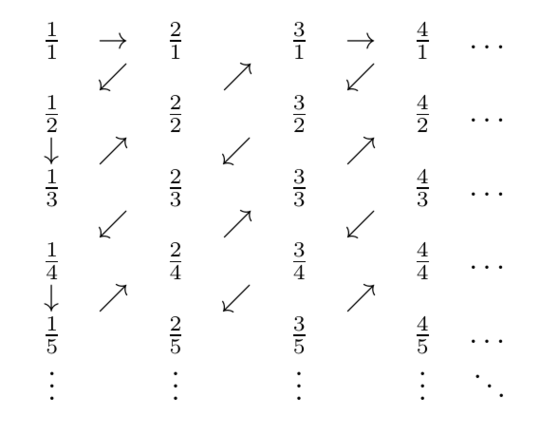14
1
The positive rational numbers can be shown to be numerable with the following process:
- Zero has the ordinal 0
- Arrange the other numbers in a grid so that row a, column b contains a/b
- Plot a diagonal zig-zag top right to bottom left
- Keep a running tally of the unique numbers encountered along the zig-zag
Here's a picture of the zig-zag:
So, the numbers encountered are, in order
1/1, 2/1, 1/2, 1/3, 2/2, 3/1, 4/1, 3/2, 2/3, 1/4, 1/5, 2/4, 3/3, 4/2, 5/1, 6/1, 5/2, 4/3, 3/4, 2/5, 1/6, 1/7, 2/6, 3/5, 4/4, 5/3 ...
And the simplified, unique numbers encountered are
1, 2, 1/2, 1/3, 3, 4, 3/2, 2/3, 1/4, 1/5, 5, 6, 5/2, 4/3, 3/4, 2/5, 1/6, 1/7, 3/5, 5/3, ...
Challenge:
- Given two greater-than-zero integers p and q, output the ordinal number of p/q
- p and q are not necessarily co-prime
- Shortest code wins
- Standard loopholes are prohibited
Test cases:
Here are the first 24 rational numbers encountered, and the desired output for each:
1/1: 1
2/1: 2
1/2: 3
1/3: 4
2/2: 1
3/1: 5
4/1: 6
3/2: 7
2/3: 8
1/4: 9
1/5: 10
2/4: 3
3/3: 1
4/2: 2
5/1: 11
6/1: 12
5/2: 13
4/3: 14
3/4: 15
2/5: 16
1/6: 17
1/7: 18
2/6: 4
3/5: 19
And, for further test cases, here are the 200 first positive rational numbers in order:
1, 2, 1/2, 1/3, 3, 4, 3/2, 2/3, 1/4, 1/5,
5, 6, 5/2, 4/3, 3/4, 2/5, 1/6, 1/7, 3/5, 5/3,
7, 8, 7/2, 5/4, 4/5, 2/7, 1/8, 1/9, 3/7, 7/3,
9, 10, 9/2, 8/3, 7/4, 6/5, 5/6, 4/7, 3/8, 2/9,
1/10, 1/11, 5/7, 7/5, 11, 12, 11/2, 10/3, 9/4, 8/5,
7/6, 6/7, 5/8, 4/9, 3/10, 2/11, 1/12, 1/13, 3/11, 5/9,
9/5, 11/3, 13, 14, 13/2, 11/4, 8/7, 7/8, 4/11, 2/13,
1/14, 1/15, 3/13, 5/11, 7/9, 9/7, 11/5, 13/3, 15, 16,
15/2, 14/3, 13/4, 12/5, 11/6, 10/7, 9/8, 8/9, 7/10, 6/11,
5/12, 4/13, 3/14, 2/15, 1/16, 1/17, 5/13, 7/11, 11/7, 13/5,
17, 18, 17/2, 16/3, 15/4, 14/5, 13/6, 12/7, 11/8, 10/9,
9/10, 8/11, 7/12, 6/13, 5/14, 4/15, 3/16, 2/17, 1/18, 1/19,
3/17, 7/13, 9/11, 11/9, 13/7, 17/3, 19, 20, 19/2, 17/4,
16/5, 13/8, 11/10, 10/11, 8/13, 5/16, 4/17, 2/19, 1/20, 1/21,
3/19, 5/17, 7/15, 9/13, 13/9, 15/7, 17/5, 19/3, 21, 22,
21/2, 20/3, 19/4, 18/5, 17/6, 16/7, 15/8, 14/9, 13/10, 12/11,
11/12, 10/13, 9/14, 8/15, 7/16, 6/17, 5/18, 4/19, 3/20, 2/21,
1/22, 1/23, 5/19, 7/17, 11/13, 13/11, 17/7, 19/5, 23, 24,
23/2, 22/3, 21/4, 19/6, 18/7, 17/8, 16/9, 14/11, 13/12, 12/13,
11/14, 9/16, 8/17, 7/18, 6/19, 4/21, 3/22, 2/23, 1/24, 1/25
Shout out to the inverse question, where the first move is down so you can't use the answers to generate additional test cases.

I wonder if there are alternative numbering schemes that make for shorter code. – qwr – 2018-06-17T23:32:44.853
1
Numerators of fractions: http://oeis.org/A157807 denominators: http://oeis.org/A157813 No matches for ordinal sequence: http://oeis.org/search?q=1%2C2%2C3%2C4%2C1%2C5%2C6%2C7%2C8%2C9%2C10%2C3&sort=&language=&go=Search
– qwr – 2018-06-17T23:38:42.793i see. you have to reduce the fraction and then count. its not the zig-zag only – don bright – 2018-06-19T04:36:50.870
Related: Zigzagify a Matrix and Reconstruct a zigzagified matrix.
– Kevin Cruijssen – 2018-06-21T14:12:16.427